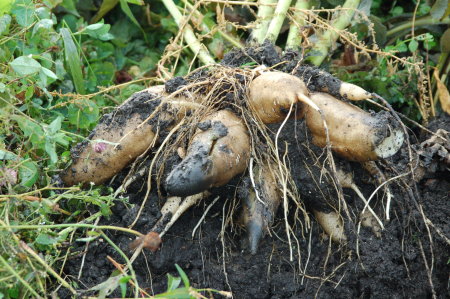
I grew two yacón plants this year, and since the first frost hit a few days ago killing the tops, it was time to dig up the plants and see what was there.
Both gave quite a substantial harvest! Frank in Belgium who gave me the tubers for these plants says they are the most productive plants in his garden, more productive than potatoes!
The roots are very fragile, and even knowing that I damaged them a bit. I think it was a mistake to use a digging fork instead of a spade, because the prongs of the fork too easily damaged the tubers.
These plants don’t seem very available in North America right now, but mostly thanks to Frank they are all over Europe.
The plants are very closely related to dhalias, the flower. If any of you have grown these in an area with a hard winter, you know they have to be brought indoors to protect from frost, and yacón is similar.
In the case of yacón, you eat the larger main tubers, and propagate it with the stem tubers. As I found out last year, the stem tubers will shrivel and die if they are separated from the plant stem before February.
According to Frank, after harvest and before eating, the plants need to sit uncovered for about 3-4 weeks in order to sweeten. After this they can be covered to help maintain moisture in storage, as well as be eaten. In my opinion, the taste is similar to melon. It’s high in the same sugar Jerusalem Artichokes contain, inulin, and so can give you gas in the same way. It can also be a good food for diabetics for the same reason.
I guess there are a couple of ways to prepare it, including cooking it lightly, but I think it tastes great raw and eaten as it is.



